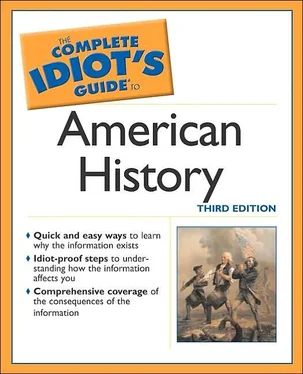Supreme Court Reigns Supreme
Although Jefferson commenced his first term as president by proposing to the Federalists that they bury the hatchet, he was not above manipulating the law to prevent a group of Federalist judges, appointed by John Adams, from assuming office. After his inauguration, Jefferson discovered that, during Adams’ final days as president, the former president had signed a number of judicial appointments but had not distributed them. Not wanting to place Federalists in important circuit court and federal court positions, Jefferson decided not to distribute the signed appointments.
When one of the appointees, William Marbury, failed to receive his commission as justice of the peace for Washington, D.C., he petitioned the Supreme Court for a writ of mandamus—an order to Secretary of State James Madison to distribute the commissions. This order created a critical dilemma for Chief justice John Marshall; if he issued the writ, he would put the court in direct opposition to the president. If Marshall denied the writ, he would dilute the power of the Supreme Court by appearing to bow to the president’s wishes. Refusing to be impaled on the horns of the dilemma, Marshall found that Marbury had been wrongfully deprived of his commission, but he also declared that Section 13 of the Judiciary Act of 1789, under which Marbury had filed his suit, was unconstitutional. Section 13 added to the Supreme Court’s “original jurisdiction” by improperly allowing into the Supreme Court a case that should be heard by a lower court. Marbury’s suit was thrown out, a political crisis averted, and-most important of all-the right of the Supreme Court to “judicial review” was established.
Ever since the case of Marbury v. Madison, the Supreme Court has functioned to set aside statutes of Congress the Court judged unconstitutional. The case represented the birth of an extraordinary federal power, which made complete the definition of the system of “checks and balances” the framers of the Constitution had created among the executive, legislative, and judicial branches of government.
Jefferson’s first term was crowned by an action that added a vast new territory to the United States. This triumph began with a crisis. Following the French and Indian War, France ceded the Louisiana Territory to Spain. However, in 1800, Napoleon Bonaparte reacquired the territory by secret treaty in exchange for parts of Tuscany, which Napoleon pledged to conquer on behalf of Spain. Napoleon also promised to maintain Louisiana as a buffer between Spain’s North American settlements and the United States. After the secret treaty was concluded, Napoleon promptly abandoned his Tuscan campaign, and the two nations fell to disputing. During this period, beginning in 1802, Spain closed the Mississippi to American trade.
Jefferson could not tolerate an end to western trade, but neither did he relish the notion of Napoleon at his back door. To resolve the crisis, the president dispatched James Monroe to France with orders to make an offer for the purchase of the port city of New Orleans and Florida.
Monroe, it turned out, was in the right place at the right time. One of Napoleon’s armies was bogged down in the disease-infested West Indies. Rather than lose his forces to illness, Napoleon decided to withdraw from the hemisphere and focus his conquests on Europe. Even as Monroe was crossing the Atlantic, Napoleon’s minister Talleyrand asked U.S. foreign minister to France Robert R. Livingston bow much Jefferson would offer not just for New Orleans and Florida, but for the entire Louisiana Territory. Negotiations proceeded after Monroe arrived, and the bargain was concluded for 60 million francs.
The Louisiana Purchase was an overwhelmingly popular move, and it catapulted Jefferson to a second term. In contrast to the tie contest of 1800, Jefferson swept every state except two-Connecticut and Delaware-in the election of 1804.
Jefferson’s second term began with great promise as his administration negotiated a favorable peace in the Tripolitan War, putting an end to intimidation by the Barbary pirates of Tripoli, Algiers, Morocco, and Tunis, who had been extorting protection money in return for safe passage of U.S. merchant vessels through the Mediterranean. Alas, the rest of Jefferson’s second administration was marked by an economic crisis resulting from a. failure of foreign policy.
In Europe, the Wars of the French Revolution had dissolved into the Napoleonic Wars. When neither the English nor the French could score a decisive victory, they turned to attacks on the commerce of noncombatant nations, including the United States. The English resumed the practice of impressing American sailors and also seized American vessels attempting to enter French ports. Jefferson retaliated with the Non-Importation Act, which prohibited the importation of many English goods.
The simmering crisis came to a head on June 22, 1807, when the British man-of-war Leopard, off Norfolk Roads, Virginia, fired on the U.S. frigate Chesapeake. The British boarded the frigate and seized four men they claimed to be deserters from His Majesty’s navy. The incident fanned the flames of war fever throughout the nation, but President Jefferson resisted. Instead of resorting to war, he pushed through Congress the Embargo Act of December 22, 1807, prohibiting all exports to Europe and restricting imports from Great Britain.
The embargo was a self-inflicted wound, severely crippling the American economy and provoking outrage from American farmers and merchants. Smuggling became rampant, national unity was threatened, and Jefferson’s popularity plummeted while that of the Federalists rose.
While Jefferson was dealing with England and France, the West that he had done so much to “open” with the Louisiana Purchase was erupting in violence. In 1794, the major tribes of the Old Northwest (the region from the Ohio River to the Great Lakes) were defeated by General “Mad Anthony” Wayne at the watershed Battle of Fallen Timbers (August 20). After almost a decade of relative peace on that frontier region, President Jefferson in. 1803 directed the territorial governor of Indiana, William Henry Harrison (1773-1841), to obtain “legal” title to as much Indian land as possible. Over the next three years, Harrison acquired 70 million acres by negotiating with whatever chiefs and tribal leaders were willing to sign deeds. The trouble was that for every Indian leader who claimed authority to sell land, another rose up to repudiate that authority and that sale.
The most prominent, brilliant, and charismatic of those who resisted the transfer of Indian lands to the whites was the Shawnee Tecumseh (ca. 1768-1813), who organized a united resistance against white invasion while cultivating an alliance with British interests. Westerners were fearful of Tecumseh and other British-backed Indians, and they were also angry. Not only did the Indians need a good whipping, but so did the British, who became the focus of concentrated hatred in the new American West, not only for inciting Indians to war, but for disrupting American shipping and commerce. What was bad for the coastal economy was disastrous for the West, which, during this critical phase of its development, was being prevented from shipping out its abundant exports. The West was spoiling for a war, and William Henry Harrison and Tecumseh would give it one.
The Least You Need to Know
The liberal “Age of Jefferson” swept away the repressive Alien and Sedition Acts and expanded the United States with the Louisiana Purchase.
Chief justice John Marshall defined the function and power of the Supreme Court through his decision in the case of Marbury v. Madison.
Читать дальше












